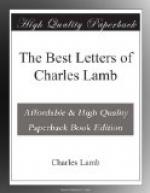C. LAMB.
[1] Coleridge contributed some four hundred lines to the second book of Southey’s epic.
III.
TO COLERIDGE.
June 10, 1796.
With “Joan of Arc” I have been delighted, amazed, I had not presumed to expect anything of such excellence from Southey. Why, the poem is alone sufficient to redeem the character of the age we live in from the imputation of degenerating in poetry, were there no such beings extant as Burns, and Bowles, Cowper, and ——, —— fill up the blank how you please; I say nothing. The subject is well chosen; it opens well. To become more particular, I will notice in their order a few passages that chiefly struck me on perusal. Page 26: “Fierce and terrible Benevolence!” is a phrase full of grandeur and originality, The whole context made me feel possessed, even like Joan herself. Page 28: “It is most horrible with the keen sword to gore the finely fibred human frame,” and what follows, pleased me mightily. In the second book, the first forty lines in particular are majestic and high-sounding. Indeed, the whole vision of the Palace of Ambition and what follows are supremely excellent. Your simile of the Laplander, “By Niemi’s lake, or Balda Zhiok, or the mossy stone of Solfar-Kapper,” [1] will bear comparison with any in Milton for fulness of circumstance and lofty-pacedness of versification. Southey’s similes, though many of ’em are capital, are all inferior. In one of his books, the simile of the oak in the storm occurs, I think, four times. To return: the light in which you view the heathen deities is accurate and beautiful. Southey’s personifications in this book are so many fine and faultless pictures. I was much pleased with your manner of accounting for the reason why monarchs take delight in war. At the 447th line you have placed Prophets and Enthusiasts cheek by jowl, on too intimate a footing for the dignity of the former. Necessarian-like-speaking, it is correct. Page 98: “Dead is the Douglas! cold thy warrior frame, illustrious Buchan,” etc., are of kindred excellence with Gray’s “Cold is Cadwallo’s tongue,” etc. How famously the Maid baffles the Doctors, Seraphic and Irrefragable, “with all their trumpery!” Page 126: the procession, the appearances of the Maid, of the Bastard Son of Orleans, and of Tremouille, are full of fire and fancy, and exquisite melody of versification. The personifications from line 303 to 309, in the heat of the battle, had better been omitted; they are not very striking, and only encumber. The converse which Joan and Conrade hold on the banks of the Loire is altogether beautiful. Page 313: the conjecture that in dreams “all things are that seem,” is one of those conceits which the poet delights to admit into his creed,—a creed, by the way, more marvellous and mystic than ever Athanasius dreamed of. Page 315: I need only mention those lines ending with “She




